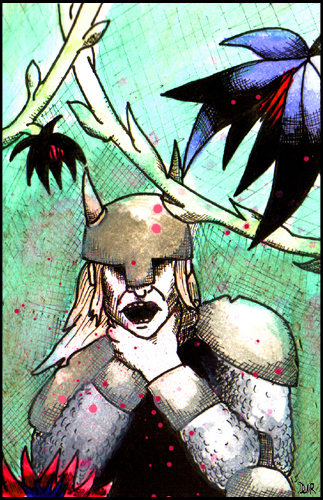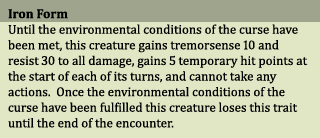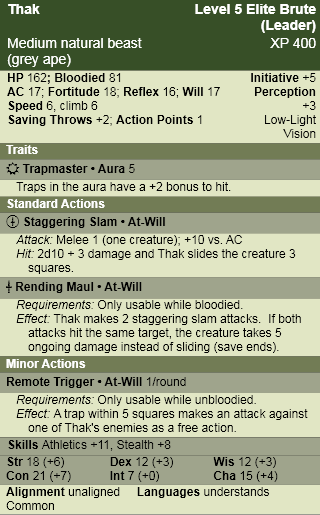Posts Tagged ‘Original Art’
Queen of the Black Coast – Part Two
April 17, 2012Instead of a classically defined monster, I thought I would use this installment of Monsters of the Hyborian Age to look at one of the obstacles Conan faces in Queen of the Black Coast and what is probably one of the most iconic species of flora in Howard’s writing – the black lotus (plus a bonus lotus). In keeping with the way the black lotus is used in the story, I think the best way to represent the plant is as a fantastic terrain feature (I could have gone with a natural hazard trap, but there didn’t seem to be enough mechanical meat to the black lotus to justify this).
As far as I can tell three other types of mystical lotus plant are mentioned in the chronicles of Conan (the purple, yellow and golden lotus – which makes the lotus a bit like the Hyborian equivalent of kryptonite), but only the black and purple varieties are suitable for D&D fantastic terrain. The juice of the golden lotus and dried yellow lotus incense are better used in-game as magic items. When Monsters of the Hyborian Age is finished, I would love to do a post with a few of the magic items Conan encountered during his adventures.
For the summary of Queen of the Black Coast, as well as the Winged One monster, click here.
Spoiler Alert! All of these Hyborian age posts are going to be filled with spoilers. From the summary, to the monster stats they are going to ruin any surprises as to what the monster is, when it appears in the story and how and why it is killed. You’ve been warned.
Fantastic Terrain
“He recoiled, recognizing the black lotus, whose juice was death, and whose scent brought dream-haunted slumber. But already he felt a subtle lethargy stealing over him.” – Robert E. Howard, Queen of the Black Coast.
The lustrous, heavy flowers of the black lotus cling to rocks and other vegetation and can be combined with any other mundane terrain feature. Any creature that ends its turn on or adjacent to a square of black lotus inhales the sinister plant’s narcotic pollen and is slowed (save ends). Creatures that fail their first saving throw become unconscious (save or the target takes damage ends). Unconscious creatures receive strange, disturbing dreams that are often prescient or retro-cognitive concerning the area the black lotus grows.
Creatures immune to poison or who do not breathe are unaffected by the pollen of the black lotus.
Purple Lotus
“Tsotha displayed a broad ring of curious design from his finger. He pressed his fingers together and on the inner side of the ring a tiny steel fang darted out like a snake’s tongue.
‘It is steeped in the juice of the purple lotus which grows in the ghost-haunted swamps of southern Stygia,’ said the magician. ‘Its touch produces temporary paralysis…” – Robert E. Howard, The Scarlet Citadel.
Clumps of purple lotus can grow in any wet or swampy location. The juice of the plant’s sap is a powerful paralytic, which makes weapon play dangerous in their midst. A creature in a square with purple lotus that takes physical damage from an attack is immobilized (save ends). Creatures that fail their first saving throw become paralyzed (save ends).
Creatures immune to poison are unaffected by the sap of the purple lotus.
Notes
“Hey… black lotus… Stygian… the best!”
I couldn’t resist.
This took me a little longer than expected (maybe I should have used some of that black lotus). I am determined to have an illustration for each Monsters of the Hyborian Age entry, but truth be told I was just not that motivated to make a picture of a flower. In the end I came up with a composition that didn’t bore me to tears, and I’m pretty happy with the visualization of the lotus’ spores, but I really hate what I did with the background…
Queen of the Black Coast – Part One
March 19, 2012It’s been far too long since I returned to the stories of Robert E. Howard, and now that a new edition of D&D looms on the horizon, I have something of a deadline to finish this project.
Queen of the Black Coast is one of my favorite Conan tales. It shows a different, more complicated side to the Cimmerian and features a powerful and engaging female character who is at least Conan’s equal (and it’s pretty easy to argue that Howard positions Belit as Conan’s superior). There’s a real epic quality to the story, and the vast span of time it covers begs the imagination to fill in the blanks. It’s not surprising Queen of the Black Coast also features some very inventive monsters (and its strange were-creatures may be one of the inspirations for D&D’s cornucopia of lycanthropes).
Spoiler Alert! All of these Hyborian age posts are going to be filled with spoilers. From the summary, to the monster stats they are going to ruin any surprises as to what the monster is, when it appears in the story and how and why it is killed. You’ve been warned.
Summary
Howard begins his tale with Conan in the thick of it, hurtling down the streets of an Argossean port city on a black stallion towards the docks. One step ahead of an angry magistrate and his men, Conan rides to the very edge of the wharf and leaps from his saddle onto the deck of the Argus, a trading galley just pulling away from the dock. After a few threats from the Cimmerian, the ship’s master agrees to take Conan along. The waters the Argus must ply are thick with pirates and Conan’s experienced blade defending the ship will put the rest of the sailors at ease.
The captain’s fears are justified, for once in Kushite waters, the Argus is set upon by the pirate ship Tigress, and her infamous master, Belit – called Queen of the Black Coast. The Argus puts up a valiant fight, but it is no match for the Tigress and the merchant vessel is soon overtaken and boarded. Bloody carnage breaks out and Conan, knowing this is his last stand, is determined to take as many of the pirates to hell with him as he can. There is something about the exotic northerner’s naked ferocity 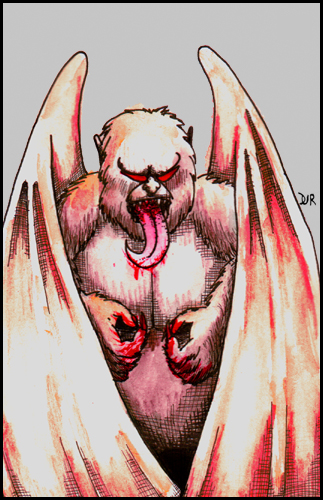 and bloodlust that intrigues Belit. She orders her men to spare Conan and offers him the chance to join her bloody rampage on the high seas. Conan is likewise drawn to the Shemite woman, not just for her unsurpassing beauty, but by the raw power of her unbridled passion. With the crew of the Argus dead, Conan joins Belit.
and bloodlust that intrigues Belit. She orders her men to spare Conan and offers him the chance to join her bloody rampage on the high seas. Conan is likewise drawn to the Shemite woman, not just for her unsurpassing beauty, but by the raw power of her unbridled passion. With the crew of the Argus dead, Conan joins Belit.
Time passes. The ferocity of Conan and Belit’s love is equalled only by the destruction the pair wreaks. The Queen of the Black Coast and her icy eyed consort become legends, their names cursed by the survivors of the Stygian ships laid waste by the Tigress. In an outburst of fevered desire, Belit promises Conan that her love burns so fiercely that not even death can keep her from the Cimmerian’s side.
Guided by rumours and forbidden lore, Belit orders the Tigress up an unnamed river, deep into an impassable, toxic jungle. The waters of the river become poisonous, and have a strange effect on the surrounding flora and fauna. Pressing on, the crew finds the ruins of a city older than mankind itself, whose former occupants Belit names ‘the old ones’. Landing, the pirates sack the ruins, finding both deadly traps and glittering mounds of treasure. Among these is a necklace with weird gems the color of clotted blood. Seized with a kind of madness, Belit becomes obsessed with the necklace, and begins acting strangely. What’s worse, the old ones are not as extinct as the pirates had hoped. The last of their kind still haunts the city, a degenerate, winged, ape-thing, who sabotages the Tigress’ supply of fresh water.
Under the effect of the necklace, Belit is unmoved, caring only for her newfound treasures. Conan, more sober minded, takes a small contingent of warriors into the jungle in search of fresh water. Tragedy strikes Conan, who succumbs to the sleep of the pollen of the black lotus plant. While he slumbers he is tormented by visions of the city’s long and terrible history. He awakens to find that the winged creature has slaughtered the entire pirate crew, including his beloved Belit, who hangs from the mast of the ship, strangled by the cursed necklace.
Filled with cold, black, fathomless rage, Conan climbs a ruined pyramid and awaits the monster for a chance at revenge. The Cimmerian is first set upon by the winged creature’s servants, a pack of were-hyenas the monster cursed in the long past. Conan is victorious, but during the melee he becomes pinned under a piece of rubble. Seeing its opportunity, the winged creature swoops down to finish Conan off, but Belit is true to her word, and her apparition appears, blocking the path between her murderer and her lover. The monster is momentarily stunned, Conan frees himself and in the bat of an eye cleaves the beast in twain.
Silent and grief stricken, the tale ends with Conan watching the Tigress sail away, alight with the flames of Belit’s funeral pyre staining the horizon.
The Winged One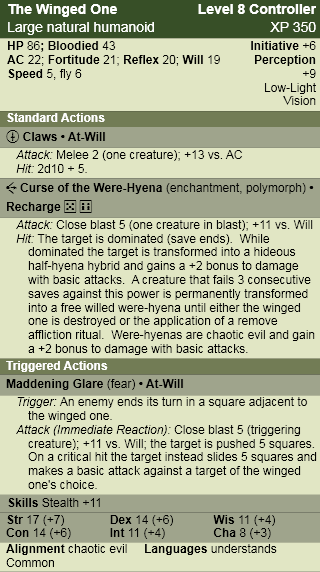
“With fearful speed it was rushing upon him, and in that instant Conan had only a confused impression of a gigantic man-like shape hurtling along on bowed and stunted legs; of huge hairy arms outstretching misshapen black-nailed paws; of a malformed head, in whose broad face the only features recognizable as such were a pair of blood-red eyes.” – Robert E. Howard, Queen of the Black Coast.
Lore
Nature 15: Superstition holds that the souls of evil men and women are imprisoned in the bodies of apes as punishment for their crimes. The vilest of these sprout wings so they can take to the air and continue to torment the living.
Nature DC 20: In the dawn of prehistory existed an exalted race of winged beings known only as ‘the old ones’. Their people reached its cultural zenith before humankind had yet crawled out of the muck, but like all civilizations, was destined to fall. A series of natural disasters rocked the old ones’ city state and polluted their drinking water with a foul substance. Those who did not die were changed, and after generations of mutation and degeneration, the twisted creatures fell on each other in a frenzy of infighting and cannibalism. Those few winged ones who still cling to hateful life are incredibly old, and know some of the weird magics of their ancestors.
The Winged One in Combat
Though devolution has robbed the winged ones of much of their people’s former intellect, they have an evil cunning that makes them dangerous foes. Before engaging an enemy directly, a winged one prefers to use distraction and sabotage (often with the aid of its servants) in an attempt to divide their enemies into more manageable groups. Often a winged one will destroy an invader’s supply of food and water, forcing them to drink from the polluted river or face the poisonous denizens of the surrounding jungle. When combat breaks out, a winged one always tries to curse the strongest looking warrior, flying off to a safe distance so it can enjoy the spectacle of the were-hyena attacking and devouring former friends.
Encounters
Winged ones haunt the jungle ruins of their former civilization, torturing themselves by watching their race’s greatest achievements slowly crumble to dust. A winged one curses any who dare intrude on its lonely vigil, transforming them into bestial were-hyenas. These creatures, as well as packs of gnolls, are often mystically bound to the area and answer the winged one’s call. The winged one reserves its bitterest rage for those foolish enough to try and steal from the temples and palaces of the old ones. The creature will stop at nothing to track down and murder these thieves, displaying their corpses as a warning to future delvers.
Notes
Like Thurgra Khotan, I think the History skill is more appropriate for Lore checks regarding the winged one, instead of following the 4e convention and using Nature checks for all creatures with the natural origin.
Inspired by the work of Tony DiTerlizzi (especially during his Planescape years) I tried my hand at coloring the illustration with traditional watercolors rather than using digital color as I have in the past. I think I need a bit more practice, but I’m pleased with the results.
Field Report: Gamma Rifts
July 24, 2011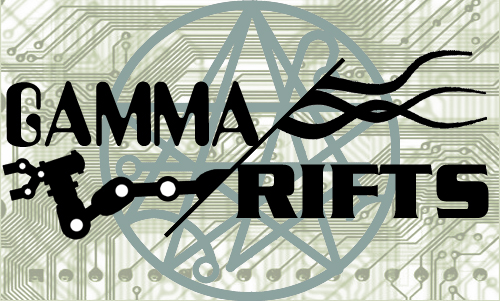 I’ve written a lot about my love/hate relationship with Rifts, so I won’t beat that horse anymore, suffice to say I’m one of the legions who love the setting and hate the system. Currently, I am using the latest edition of the Gamma World game to run a campaign set in the world of Rifts (the basic modifications to the rules are here, and a set 30 of Rifts flavoured Omega Tech cards are here). That campaign is well underway, and I thought I would share some of the tabletop experiences as an example of how a Gamma Rifts game can work.
I’ve written a lot about my love/hate relationship with Rifts, so I won’t beat that horse anymore, suffice to say I’m one of the legions who love the setting and hate the system. Currently, I am using the latest edition of the Gamma World game to run a campaign set in the world of Rifts (the basic modifications to the rules are here, and a set 30 of Rifts flavoured Omega Tech cards are here). That campaign is well underway, and I thought I would share some of the tabletop experiences as an example of how a Gamma Rifts game can work.
After a couple of sessions we’ve played through ninety percent of a Rifts modified version of the introductory adventure, Steading of the Iron King (my next post will cover the modifications I made to the adventure as well as some of the handouts I used for it).
The Good
I’m very pleased with the game so far. The looser, more streamlined rules have been fun. While the abstract nature of the rules governing weapons and armour might be off-putting to Rifts purists (a baseball bat with a nail in it does the same damage as a vibro-knife), I haven’t missed a dozen books worth of guns or keeping track of all that ammunition (another aspect of Gamma World that has been taken to the abstract level). In fact, freed from the restrictions of a highly detailed equipment list, everyone had a ball making up their own weapons and armour during the character creation process (more on that later). It might be a less realistic approach to weapon damage, but it does a far better job than Rifts ever did of allowing for the broad range of character types drawn from the multitude of sources that inspire a kitchen sink science fantasy game (and have them still be useful to the party and fun to play that is).
The Rifts set of Omega Tech cards printed up beautifully (better than I thought they would actually), for the price of less than 2 WOTC booster packs at Kinkos, and mesh nicely with the cards contained in the boxed set. The mix of the Gamma World and my own splugorth, techno-wizard and magic items did a good job of reinforcing the nature and feel of the setting.
Most importantly, the feel of the game at the table captured the best elements of Rifts – quirky, bizarre characters having madcap adventures in a dangerous and deadly serious world that is often contradictorily ridiculous and funny.
The Bad
While Gamma World does a great job of recreating what I call the ‘street level’ of Rifts (city rats, cyborgs, juicers, ley-line walkers and mind melters), it isn’t that great at emulating the epic side of Palladium’s signature game (mega damage, pistols that can put a hole in a mountain, easy access to long range nuclear missiles, and characters that can fly at Mach 2 at first level). This wasn’t a big deal for me, as those were aspects of the game I never really felt were integral to the setting, but others may feel differently (I had long toyed with the idea of running Rifts using the notes in the Rifts Conversion Book to convert everything to SDC as a way of dealing with the game’s problems – so that gives you an idea of where I’m coming from).
Finally, if you hate 4e D&D (which provides the core ‘engine’ of Gamma World), you’re going to hate using Gamma World in any setting. The abstract level of many of the rules (equipment, ammunition, healing outside of combat, and the Alpha and Omega cards) can be a turn-off to players with a more simulationist bent.
The Party
The best way to demonstrate how a Gamma Rifts game actually plays out is to take a look at the party of adventurers my players put together for our campaign (check out their portraits at the end of the post). Character creation in Gamma World is fun, and the addition of figuring out how the two origins worked with the character’s power source (tech, magic or mutant), only added to the process.
My players rolled their origins but chose their power source based on suggestions from me and the other players of how such a character might be envisioned (for example he Wheeled origin and the tech power source might produce a tracked cyborg like the ones in the Russia worldbook, while the mutant or magic power source with the same origin could be interpreted as some kind of centaur creature). Often, the ideas that were generated during character creation were also informed by the random skill bonus each Gamma World character receives.
We are still getting used to interpreting the Alpha cards according to power source and not just as a mutation (spells for magic, and gadgets for tech characters), but I think that will get easier with a little nudging from me and the inclusion of more game elements that are affected by power source differently (things like gamma terrain, hazards, and monster powers).
Once the rolling was finished, I asked each of my players to describe themselves, their armour and weapons, and come up with a reason why they were members of a band of mercenaries working for the city of Lazlo (the set-up of the first adventure that I’ll detail next post). It wasn’t far into the first session that my friends dubbed their party ‘the Misfits’, and besides being an unforeseen Jem reference (which is cool in itself), describes them pretty well.
Lazarus Project Subject E (Laz-E to his friends, for his slow movement rate), is a dead man with no memory of his former life, resurrected and powered by a large graviton reactor in his chest. He wears armour made from the cast off junk he found in the destroyed lab where he was ‘born’ and wields an old parking meter in combat that occasionally spits out strange coins. He joined up with the Misfits by accident, hoping one day to uncover the mystery of his origin. [Re-animated/Gravity Controller with the Tech power source wearing heavy armour and using a heavy 2-handed melee weapon]
Willow is the spirit of a Dryad who survived the destruction of her bonded tree, constantly weeping a slow trickle of tear-sap from haunted eyes. She wears the bark of her former home as armour and wields a greatclub made from the tree’s thickest branch. She joined the Misfits as part of her crusade against the Coalition, whose engines of war destroyed her grove. [Yeti/Ectoplasmic with the Magic power source wearing heavy armour and using a heavy 2-handed melee weapon – there was already an actual Yeti in the party so the Yeti origin’s bonus to Nature, combined with another bonus to Nature through the random skill bonus roll, led to the interpretation of the character as a nature spirit, the Yeti’s claws becoming thorny branches]
Big Claw is a Yeti fire warlock. She wears armour made from cast off metal scraps, uses a manhole cover as a shield, and wields a magic sword made from the unmeltable ice of the North Pole. She joined the Misfits to aid in her search of the southlands for a piece of ‘hairless ape magic’ (technology) that can reunite her with her northern tribe, and bypass her enemies in the Coalition state of Iron Heart. [Yeti/Pyrokinetic with the Magic power source wearing heavy armour, shield, and using a heavy 1-handed melee weapon]
The Master looks human, but insists he is a ‘time lord’, and constantly reminds others of their species’ inferior status. He wears a personal force field projector on his back and wields a handheld disruptor. He joined the Misfits hoping the techno-wizards of Lazlo would aid him in repairing his destroyed transport, which he calls a TARDIS (and the Misfits keep him around because he’s a mechanical genius). [Electrokinetic/Temporal with the Tech power source wearing heavy armour and using a light 1-handed gun – the Master’s personality is the direct result of his abysmal Charisma score]
Paranoia is a risk averse Mind Melter whose psychokinetic abilities are so strong she can rip other versions of herself from parallel dimensions into her own reality (usually to die horribly in her place). She wears a jacket of red dragon scales as armour, uses a large dragon scale as a shield, and wields a baseball bat with a nail though it. She was born in Lazlo, so helping with the war effort comes naturally… joining the Misfits means she doesn’t have to follow orders or stick around if the Coalition war machine comes calling. [Telekinetic/Doppelganger with the Mutant power source wearing light armour, shield, and using a light 1-handed melee weapon]

Notes:
Just a quick note about the illustration. This is how I picture the Misfits in my mind when we play – I’m sure my players see themselves differently in the game world (after all I’m only working with a brief description – they’ve got the whole mental picture), but I tried my best … Finding good reference material for a female yeti is very difficult (in the end I went with Marvel’s Snowbird in Sasquatch form).
Back in high school, when my friends and I ended our epic 2e Temple of Elemental Evil campaign, we commissioned an artist at Toronto’s Pandemonium convention to sketch a portrait of our party. I can’t remember the name of the artist (and I don’t have a copy of the picture), but I have newfound respect for his talents – even more so that he was able to get it right.
Shadows in the Moonlight – Part Two
July 16, 2011The Shadow in the Trees is the second creature from Robert E. Howard’s story, Shadows in the Moonlight. For the summary of that tale, as well as the iron shadow monster theme, click here.
This is also the second of Howard’s man-eating grey apes that I’ve featured in this series. The first, Thak, appeared in Rogues in the House (and before I’ve finished with Howard’s stories, there will be at least one more).
Spoiler Alert! All of these Hyborian age posts are going to be filled with spoilers. From the summary, to the monster stats they are going to ruin any surprises as to what the monster is, when they pop up in the story and how and why they are killed. You’ve been warned.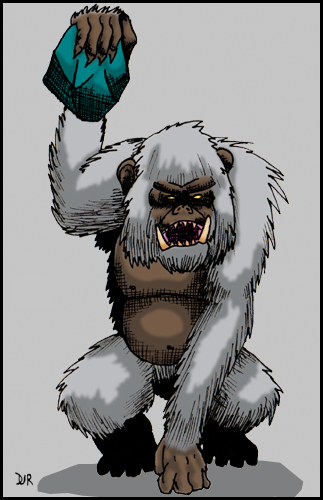
The Shadow in the Trees
“In general outline it was not unlike a man. But its face, limned in the bright moonlight, was bestial, with close set ears, flaring nostrils, and a great flabby-lipped mouth in which gleamed white tusk-like fangs. It was covered in shaggy grayish hair, shot with silver which shone in the moonlight, and its great misshapen paws hung nearly to the earth.” – Robert E. Howard, Shadows in the Moonlight.
Lore
Nature DC 15: Grey apes are a brutal and savage species of carnivorous primate that dwell in lonely mountains and hills. Their minds are more developed than true apes, and they often employ crude tools and weapons, though they are no less capable of ripping an enemy apart with their bare hands. It is prophesized that grey apes will one day evolve into a species that will challenge humanity for dominance.
Nature DC 20: Some grey apes have honed the skill of rock throwing to such a degree that they can rebound a single stone between two targets. These apes hide caches of projectiles throughout their hunting grounds, each carefully chosen for its weight and balance. Against large groups of enemies, grey apes hurl massive chunks of brittle stone that explode in a shower of painful and debilitating shrapnel.
The Shadow in the Tree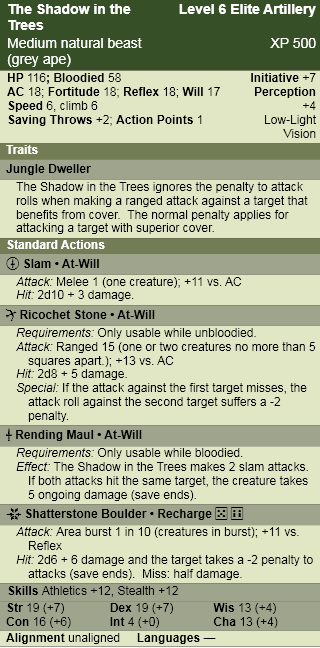 s in combat
s in combat
The Shadow in the Trees is a wary and cunning hunter. From behind a barricade of natural cover, or difficult terrain, it surprises its prey with a veritable barrage of hurled missiles. Only when its broken victims have stopped screaming, does the carnivorous ape move in to feed.
Like all grey apes, the Shadow in the Trees is prone to fits of bestial anger. When wounded, the ape is possessed with a homicidal fury, dropping its weapons and abandoning caution to rip and tear the source of its pain to bloody shreds.
Encounters
The shadow in the trees is drawn to ancient, vine choked jungle dungeons, where crumbling walls and loose flagstones provide the creature with ample ammunition. These forays bring the ape into contact with a wide assortment of strange creatures. In such an environment, the adaptable grey ape will utilize mindless denizens, like oozes and undead, as a natural bulwark against attackers. In turn, more organized creatures, like bugbears and gnolls, are eager to press a creature like the Shadow in the Trees into service with steady bribes of raw meat.
Notes
My main goal with the Shadow in the Trees was to extrapolate on the mechanical design of Thak, the first grey ape, without making a carbon copy. I like that Thak is essentially two creatures in one – a leader who relies on traps who transforms into a straight hand to hand brute when it becomes bloodied. That way, halfway through the fight, the creature’s altered tactics keep the players on their toes.
I continued that theme when I made the Shadow in the Trees. It’s an artillery creature that avoids melee characters, who transforms into a hand to hand brute that rushes into the thick of the fight (cribbing its bloodied attack from Thak which I thought provided a nice mechanical thread between the two monsters). The coolest part is how well this approach reflects the events of the story (the beast spends most of the tale hurling rocks from the concealment of the forest, only to emerge and confront Conan directly when its volatile rage gets the better of it).
When I create the next grey ape (which is about 8 stories away – so not anytime soon), I’m definitely going to continue with this pattern. One of the things I love about the 4e bloodied mechanic is that it lends itself so well to these Jekyll and Hyde type transformations (though I guess in the case of the grey apes it’s Hyde and Hyder).
I Levelled Up!
July 5, 2011There are certain recognized milestones for a D&D character’s development – a wizard learns fireball, a fighter gets a second attack, a rogue trains a skill up to +20… when it comes to personal, real life development, the milestones come with less frequency and are certainly less impressive.
But I’m proud of myself anyway. My milestone? I created my first cover. Here’s the backstory. I’ve been posting my favourite Dragon magazine covers from different eras, saturating my brain with great art. One of the reasons I create my own pictures for the monsters I produce on this website is so that I can get back in the swing of drawing regularly again (an activity that I’ve associated with RPGs since I was a kid, but exercise less and less as I get older). It’s great practice that comes with its own built-in impetus (for a guy like me, that’s the best kind of impetus); I hate monster stat-blocks without an illustration. Reminiscing over those back issues of Dragon inspired me to begin experimenting with color in my pictures.
Meanwhile, while perusing the RPG Blog alliance, I noticed that Mark at Mithril and Mages was holding a contest to design a cover for his application, Treasure Book on Demand (a very cool program that randomly generates a whole book in pdf form, with treasures for every ‘hoard class’ in the Labyrinth Lord game – that’s the same as ‘treasure type’ in 1e D&D). He was looking for an A4 sized illustration in colour – just the thing I’d been experimenting with. I thought to myself, I could do that (in a fit of un-me-ness). And I did. Here’s what I made. And it won!
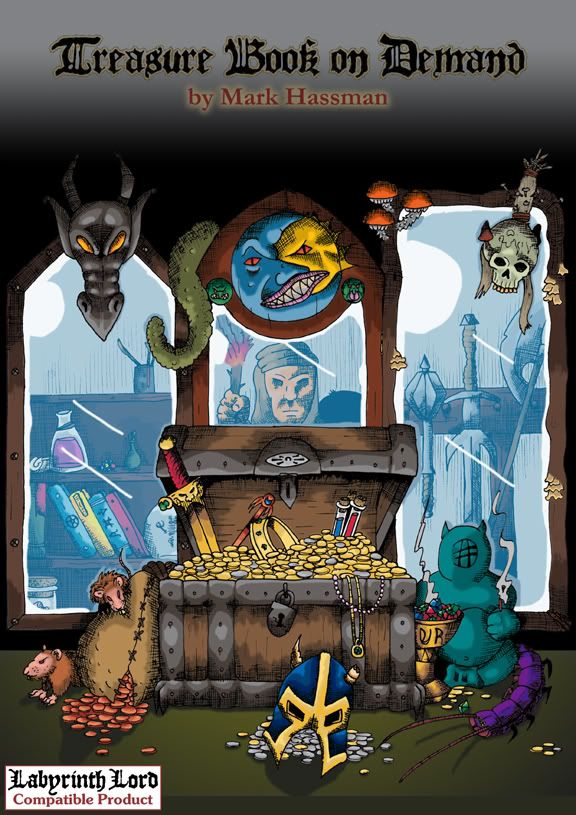
OK, there were only two people who entered, but Mark was classy enough to give us both first prize. That was awesome (and greatly appreciated), but the real milestone is that I was able to fill up that page with something, and even though I can already see a lot of things that I would like to change (I admit that time constraints made me rush the images that appear in the mirrors – and it shows), I’m very proud of the finished product. It was a lot of work, but like any adventurer who manages to make it out of the dungeon bruised, bleeding, but alive; I think I’ve learned a few tricks and expanded my skill-set.
For the basic design of the piece, I wanted a chest full of riches, with a set of mirrors reflecting different sorts of treasures (as a way to show how the Treasure Book can generate infinite combinations). Then I tried to jam in as much detail as possible, because in any haul, it’s the little things that are always the most exciting.
Seeing as Labyrinth Lord is a retro-clone, I went back to the old school masters for inspiration when gathering reference material (like I needed an excuse). Some of the tributes are obvious, others a little more obscure (especially the not-exactly D&D ones). For those who don’t like spoilers, I’m putting the sources of all the picture’s ‘Easter eggs’ in the comment section.
It might not be Dragon material, but it’s my fireball (or at least Melph’s minute meteors).
Shadows in the Moonlight- Part One
June 21, 2011There is a lot for DMs to learn in Shadows in the Moonlight. In D&D terms, the island where the action of the story takes place is definitely a location based adventure, but it is also an amazing example of what game designers call a ‘living dungeon’ – one where the actions of the PCs influence the actions of the NPCs and both react to the island’s set encounters.
This story has the added bonus of a female character who subtly subverts the whole damsel in distress motif that was bothering me a few stories ago. Yes, Olivia is a damsel in distress, but she’s also capable of driving the plot forward on her own, and is more than just a prize to be won by the Cimmerian at the end of the story. In fact, although told in the third person, the story is obviously from Olivia’s point of view, making her the reader’s ‘eyes’.
Spoiler Alert! All of these Hyborian age posts are going to be filled with spoilers. From the summary, to the monster stats they are going to ruin any surprises as to what the monster is, when they pop up in the story and how and why they are killed. You’ve been warned.
Summary
Howard’s tale begins with Olivia, daughter of the King of Ophir, sold into slavery because she would not marry a King of Koth, fleeing her former master, the Hyrkanian Shah Amurath. On the swampy boundary of the Vilayet Sea, Shah Amurath reaches his quarry. As fate would have it, the salt marsh is also the temporary refuge of Conan, himself fleeing from Shah Amurath’s troops who had recently slaughtered the Cimmerian’s rogue mercenary army, the Free Companions. Mad with starvation and a burning desire for revenge, Conan throws himself at Amurath. The Hyrkanian’s superior weapons and armour pale before the furious onslaught of the barbarian, and in a few bloody moments of mad butchery he is cut down. His bloodlust sated, Conan returns to his senses and introduces himself to Olivia. Soon after, the pair decides to escape in a stolen rowboat before they are caught red handed by the deceased Shah’s men.
After a day of hard rowing, Conan lands the craft on a small deserted island to rest and gather some food. It isn’t long before they are ambushed by a huge hunk of hurled stone. Conan investigates, and after a few moments draws his weapon, grabs his companion and slowly backs out of the trees. Whatever it is that had unnerved the barbarian, Olivia cannot see it.
Moving through the island’s grassy hills, the two stumble upon the ruins of an ancient building. Eager to get as far from the jungle as possible, Conan and Olivia enter. Inside they find the hall of the long, low building is filled with incredibly lifelike iron statues of unsettling humanoids. The sculptures are disturbing, but poking and prodding reveal them to be as solid as they appear. Safe from their mysterious jungle stalker, Conan and Olivia drift off to sleep.
Instead of blissful rest, Olivia is plagued with an incredibly realistic nightmare. She sees the building as it once was, filled with the humanoids depicted in the statues. They torment a beautiful angelic figure chained to a pillar. To no avail, the angel creature wails to the heavens. A moment later, the dark humanoids open its throat in bloody sacrifice. Suddenly, the skies open wide and a being that could only be described as an exquisite and terrible god steps down among the savages. Cradling the body of its slain progeny, the god pronounces a powerful curse in its alien tongue. The humanoids freeze, transfixed, their bodies metamorphosed into solid iron. The deity then points to the moon, hanging in the night sky, and departs.
Olivia wakes screaming, and despite Conan’s protests that the statues are harmless, manages to convince the barbarian to leave at once. As frightened as she is about the iron figures coming back to life, Conan is more concerned about whatever lurks in the concealing jungle, so the pair take refuge on the island’s rocky cliffs.
The next day, from their high vantage point, Conan spies a pirate ship pulling ashore, spilling its ragtag occupants in search of supplies. The barbarian knows the ship is the best opportunity to safely leave the island and be rid of the Hyrkanians, so he hatches a scheme. In case his plan doesn’t work, Olivia hides while Conan confronts the pirates of the red brotherhood.
Unfortunately, the leader of the pirates is already well acquainted with Conan, and has a score to settle. Outnumbered, Conan goads the pirate captain into single combat, and handily slays him. Before he can parlay the victory into something more, an overzealous pirate brains Conan with a sling stone. Without the iron hand of a leader to guide them, the red brotherhood argues amongst themselves over the fate of the unconscious and bleeding Cimmerian.
Unaware of Olivia, the pirates bind Conan and drag him back to the ruins, where they set up camp for the night. Fearing the coming evil of the moonrise, Olivia braves both the jagged cliff face and pursuit by the shadowy stalker that has hounded them since their arrival. Inside the ruins, she creeps past the sleeping and drunken pirates to free Conan and escape.
They do not make it far when they finally meet Olivia’s pursuer face to face. Their mysterious assailant emerges from the shadows; a bestial man-eating grey ape. It was time for a reckoning in the only manner that Conan knew how. Barbarian and beast clash, but with the advantage of steel, Conan leaves the ape a broken and dismembered corpse.
The jungle brute was dead, but the island had yet to play its final hand. From the ruins came a series of bloodcurdling screams, the clash of steel, and the sound of unbridled butchery. Olivia’s dream had come to pass – the moonlight had just reached the crumbling building. Not eager to see the nightmare first hand, Olivia and Conan take flight to the pirate’s abandoned ship.
The morning light brings a small group of wounded and shaken pirates who managed to escape the massacre with their lives. Conan allows them to board what was once their ship – provided they acknowledge him as their captain. With a ship and a crew to replace the Free Companions, Conan was ready once again to plunder his way to vengeance across the inland sea.
Iron Shadow
“They were statues, apparently of iron, black and shining as if continually polished. They were life-sized, depicting tall, lithely powerful men, with cruel hawk-like faces. They were naked, and every swell, depression and contour of joint and sinew was represented with incredible realism. But the most life-like feature was their proud, intolerant faces.” – Robert E. Howard, Shadows in the Moonlight.
When the gods are angered the world trembles. When there is a blasphemy so obscene it demands justice, such as the ritual murder of a deity’s demigod offspring, the gods do not act through proxies, and iron shadows are left in their wake.
Iron shadows are the product of an ancient divine curse, transformed into metal statues to guard over the site of their cosmic crime until the end of time. As such, they are usually found in the crumbling remains of prehistoric dungeons, the ruins of primordial temples, and on blasted mountain peaks shunned by all sentient races. They are immobile, forced to watch without being able to act, until an environmental condition, laid out at the time of their cursing is satisfied. Such a condition could be anything from the light of the moon to a breath of air in a subterranean chamber, but once it has been met, the iron shadows are temporarily transformed back into flesh and blood creatures; free to release centuries of bottled hatred on any unfortunate enough to cross their path.
Only the gods themselves know why they would allow the objects of their curse even the briefest freedom from punishment. Perhaps the terror iron shadows invoke serves as a reminder to the world the consequences for the ultimate blasphemy.
Only the most depraved of the thinking races have incurred this divine curse, including black ones, derro, drow, gnolls, goblins, humans, kuo-toa, and troglodytes. Some iron shadows are so old that they have outlived their decadent civilizations, and even the names of their species are lost to the sands of time.
The iron shadow theme adds an element of lurker to any monster, and works best on a group of creatures in a set-piece encounter that reinforces the blasphemous act that offended the divine. Alternatively, iron shadow themed monsters work well in an area the characters must travel through frequently, and have been lulled into a false sense of security by the statues’ prior inactivity.
Skill Modifications: +2 bonus to Stealth, and a +2 bonus to one of the following knowledge skills – Arcana, Dungeoneering, History or Religion.
Traits
All iron shadows gain the following trait, which simulates their cursed sta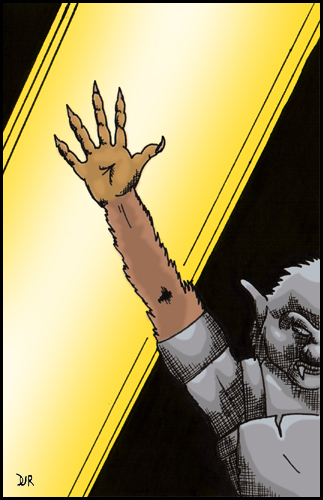 te:
te:
Attack Powers
The nature of their curse means that Iron Shadows most often attack from surprise, surrounding their foes and bringing down the weakest targets as quickly as possible. Although the survivors of such an onslaught often flee, the divine magic of the iron shadows’ curse binds them to the area and prevents pursuit.
Fearsome Aspect
This power emphasises the sudden and frightening nature of an iron shadow attack. It works best in an encounter area that directly blocks the characters’ objective, since all or some of the party may be forced to flee.
This power makes the opening attack of a lurker even more devastating, or adds an element of lurker to any other monster role.
Relive the Nightmare
When added to a lurker (or other creature with bonuses against targets that grant combat advantage), this power helps to increase damage potential. Relive the nightmare also gives the dungeon master the opportunity to describe the events surrounding the iron shadow’s curse, and inject pieces of narrative into the combat.
Utility Powers
Iron shadow utility powers focus on keeping lurkers and artillery alive long enough to cause the maximum amount of damage.
Centuries in Iron
Over time, some iron shadows have learned to harness the deific curse to their own advantage. This protective power is especially useful for lurkers and artillery that are prone to succumbing to the effects of focused damage.
Palpable Hatred
This power helps to protect artillery from melee combatants, keep skirmishers mobile and prevent lurkers from being surrounded by foes.
Notes
Wow, I’ve never made a theme before and I have to admit it was a lot more work than I thought it would be (much more than creating a single monster, which in hindsight makes sense). Of course, the fact that the battle with the monsters isn’t directly described in the story didn’t help either. Still, I think making a theme to represent the isle of iron statues was definitely the right choice. This way, almost any creature can be turned in to what amounts to an iron gargoyle – which I think has a lot more utility than a single similar monster.
I’m pretty sure that the statue creatures in the story are the black ones from the Pool of the Black One (their physical description is comparable as well as the strange green stone of their buildings). I find the presence of these creatures in both stories very interesting for what it means about the setting of the Hyborian age. In his essays, as well as the Conan and Kull stories, Howard writes at length about the ancient civilizations of the serpent people, Stygia and Acheron, but he makes no mention of the black ones. Being present as far west as the Atlantic, and as far east as the Vilayet, suggests remnant pockets of what at one time must have been a much more widespread race (plus the green stone of the city of Xuthal in the south suggests that they may have been the original builders), probably incredibly old even in Kull’s time, before Atlantis sunk beneath the waves. A quick internet search reveals I’m not the first person to question the relation between these stories, but it’s still an interesting point to ponder nonetheless.
Random Encounters: Ilya Ivanov, real life Dr. Moreau
June 10, 2011I’ve always thought the RPG Blog Carnival was a cool idea – a group of writers coming together just for the fun of exploring an interesting theme (like a digital flash mob); but the topics covered so far have been outside of the focus of this site. Fortunately, this month’s host for the carnival, Dungeon’s Master, have set a theme I can really sink my teeth into: RPG characters based on real life people (using no less awesome an example than Seth Grahame-Smith’s Abraham Lincoln, Vampire Slayer).
Growing up, my father, an electrical engineer, taught me a healthy respect for alternating current, so naturally my first choice was Nikola Tesla, but Greg at Lungfishopolis beat me to the punch. So I decided to move on to another, lesser known eastern European ‘mad scientist ’, Ilya Ivanov.
’, Ilya Ivanov.
Ilya Ivanov was a Russian biologist who worked from the turn of the century until the early 1930’s. He pioneered revolutionary artificial insemination techniques and used the technology to create a wide variety of hybrids, including zebra-donkey, antelope-cow, and rabbit-guinea pig mixes (hello owlbear!). As if that wasn’t enough RPG fodder, Ivanov is most infamous for his efforts to create a human-ape hybrid. His first attempts using apes impregnated with human sperm failed. Logically then, the next step was to impregnate human females with ape sperm. In spite of actually having a volunteer willing to carry the hybrid, Ilya Ivanov was arrested in one of Stalin’s shakedowns of the Russian scientific community before he could get the experiment underway. As far as I know, Stalin had no moral objection to human-ape crossbreeds, and the arrest was a purely political one. Ivanov never got a chance to return to his mad work, dying in exile in Kazakhstan in 1932.
Not surprisingly, since then Ivanov pops up regularly in conspiracy theories, fringe science, and pop culture every few years (or the shadow of his ideas do). The forbidden and frightening act of creating a human hybrid, mixed with the sinister exoticism of Stalinist Russia is a brew too powerful to resist. Seriously, we’re talking about an army of cold war, soviet, super apes! That’s pure gold.
The legacy of Ilya Ivanov can be felt in the classic Fantastic Four villain Red Ghost (and his super apes), in DC’s Gorilla Grodd, and in the Planet of the Apes movies (including the soon to be released reboot, Rise of the Planet of the Apes).
Taking my cue from Seth Grahame-Smith, I’m going to use a similar over the top approach; one that posits Ivanov succeeding where h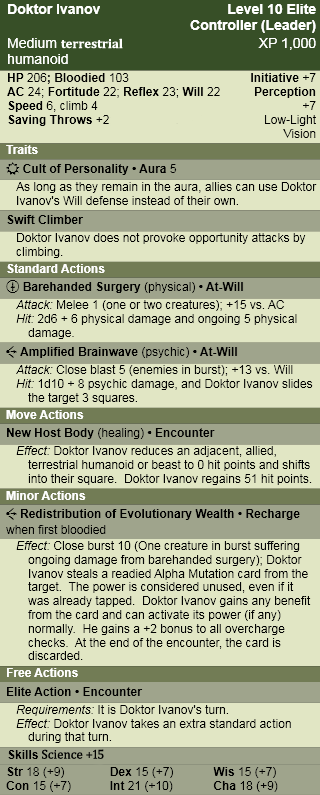 istory tells us he failed. And I can think of no better RPG suited to house Ilya Ivanov than one already filled with mutant animals, a blatant disregard for the laws of nature and bucket loads of cold war sensibility: Gamma World.
istory tells us he failed. And I can think of no better RPG suited to house Ilya Ivanov than one already filled with mutant animals, a blatant disregard for the laws of nature and bucket loads of cold war sensibility: Gamma World.
I present, for use with the current edition of Gamma World (as well as Dungeons and Dragons), Ilya Ivanov and his super apes.
United Soviet Simian Republic
“Species of the world, unite! (Literally)”
Ilya Ivanov was a soviet scientist who worked to create the first human-ape hybrid. In most realities he failed and was arrested by Stalin, but in a few, the mad visionary was able to escape imprisonment and create an army of super apes. With his hybrid commandoes, Ivanov quickly overthrew Stalin and carved out a new Soviet empire. Ivanov, in his role as dictator, ushered in an age of undreamed scientific progress untainted by political ideology, and unfettered by morality or ethics.
By the time of the Big Mistake, Ivanov had ‘outgrown’ his old, perishing body and had transferred his brain to a series of simian hosts.
Doktor Ivanov
“You know how I know that monkey is smart? I can see its brain.”
Doktor Ivanov lost the last shreds of his empathy when he abandoned his human body and put his brain in a jar. Now he views everything through the cold, detached lens of a science experiment. In combat Ivanov uses his bestial strength to rip raw hunks of meat out of his opponents, analyze their genetic imprints, and absorb any beneficial mutations found for further study. Should his host body become damaged in his pursuit of test subjects, Doktor Ivanov doesn’t hesitate to transfer his brain to one of his humanzee ‘children’. That the process decapitates the host doesn’t seem to bother either Ivanov or his creations.
Humanzee Shock Trooper
“To err is human, to ape divine.”
Humanzees combine humanity’s capacity for war and violence with the strength and agility of an ape. They are the perfect soldiers, and ob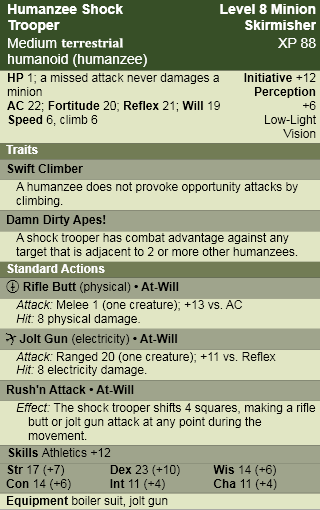 ey strong commanders without question so long as there is war to wage. Even on Gamma Terra, there is little more horrifying than seeing the raw hatred and naked brutality of a swarm of boiler suited humanzees washing over their foes like a crimson tidal wave.
ey strong commanders without question so long as there is war to wage. Even on Gamma Terra, there is little more horrifying than seeing the raw hatred and naked brutality of a swarm of boiler suited humanzees washing over their foes like a crimson tidal wave.
LoreAlthough he built his empire with the savage power of human-ape hybrids (and they remain his most successful creation), Doktor Ivanov experimented with many other human –animal combinations. With the proliferation of creatures such as badders, hoops, dabbers, fen, and porkers wandering the wastes one has to wonder if prevailing origin theories are wrong and these beasts are actually the orphaned offspring of Ivanov’s abandoned experiments.
Notes
I did it. I made another ape monster even though I promised I would keep them to a minimum. I really did want to stat-up Tesla, and when I was looking around for other real life mad scientists to replace him Ivanov just jumped out at me. I’m glad I broke my promise though, I really like how everything came together (there were a few Gamma World monsters that affected the use of Alpha and Omega cards but nothing that took advantage of the card mechanic itself, so I wanted to incorporate that into the design). Plus, I really wasn’t happy with how the picture for Thak turned out, and I wanted another shot at drawing a primate before the next instalment of Monsters of the Hyborian Age.
Incidentally, the brain in a jar aspect of the monster was inspired by another Russian, a contemporary named Sergei Bryukhonenko, who invented a heart and lung machine that could keep a dog’s head alive and responsive detached from its body. I’m sure Ivanov would have had access to that technology during his soviet renaissance of scientific research.
Rogues in the House
May 28, 2011Beyond being a great crime/horror story, Rogues in the House is especially interesting to gamers as an example of the literary roots of D&D’s city adventures. While the obvious choice for such inspiration is Fafhrd and the Grey Mouser’s adventures in Lankhmar, I think that Rogues in the House provides a darker and grittier counterpoint to Fritz Leiber’s more whimsical tales. Thievery, corruption, political intrigue, backstabbing, and assassination – this story has more than enough fodder for any DM looking to mine ideas for urban adventures.
Spoiler Alert! All of these Hyborian age posts are going to be filled with spoilers. From the summary, to the monster stats they are going to ruin any surprises as to what the monster is, when they pop up in the story and how and why they are killed. You’ve been warned.
Summary
The events of this tale take place not long after The Tower of the Elephant, featuring a somewhat wiser Conan, though no less wild and dangerous.
The story begins with the subtle and deadly political manoeuvrings of Murilo, a young and ambitious noble selling the secrets of his city to the enemy, and Nabonidus, a Red Priest who uses his religious position to control the city’s ruler for his own personal gain. Nabonidus sends Murilo a message, a gilded box with the ear of one of the nobleman’s confederates. Clearly, Murilo has been marked for death. In need of a hired sword to assassinate the Red Priest before his enemy can strike, Murilo seeks out Conan, who has earned a dangerous reputation in the city’s slum.
Luckily for Murillo, Conan has been imprisoned for the murder of a different priest (who happens to be a double crossing fence), and is in need of a favour to avoid the headsman’s axe. Conan agrees without hesitation to Murilo’s bargain – in exchange for his freedom he will kill Nabonidus before the sun rises.
Unfortunately for both men, the guard that Murilo had bribed to free the Cimmerian is arrested before completing his task. Overcome with panic, Murilo grabs a sword and heads to the Red Priest’s estate to deal with Nabonidus personally. Once there, he finds the guards have already been slain, yet not by human hands. Eventually he finds Nabonidus slumped over a table, his features hidden by the enveloping folds of his signature red cloak. Stealthily Murillo moves to strike, but the figure wheels around, revealing not the Red Priest but a hairy monster that quickly overpowers the noble and knocks him unconscious.
Meanwhile, Conan has escaped prison on his own, crushing his jailor’s skull with a joint of beef he had been eating (a classic move every warrior since has dreamed of repeating). Although there is nothing holding him to his bargain, he keeps it anyway, sneaking into Nabonidus’ abode through the sewers. There he encounters the first of the Red Priest’s traps – an iron portcullis that swings down, trapping the barbarian in the estate’s dungeons. It is not long before he runs into the shaken Murilo, and with little other choice, the two press on to find and slay their captor.
Eventually they cross paths with none other than Nabonidus himself, recovering from a blow to the head and trapped within his own dungeon. After some back and forth a truce is called (against Conan’s instincts to simply kill the Red Priest and be done with it). Nabonidus and Murilo agree to forget their transgressions against one another and cooperate in order to escape. It seems that the beast the young noble encountered wearing Nabonidus’ robe is Thak, the Red Priest’s pet grey ape. Nabonidus raised the creature from a cub and trained it to be his bodyguard and servant, but it turned against him this night and slew the rest of his minions.
Nabonidus leads the pair to the only exit from their dank prison, a door that leads back up to the building above. Before they leave, Nabonidus uses a series of periscopes he has hidden in the dungeon to spy on the chamber above, confirming his worst fears. Thak is waiting patiently for them. But what is worse than facing the creature’s brute strength is that he has mastered the household’s deadly traps. The Red Priest assures Conan and Murilo that to open the door while the ape watches is certain death.
While the trio debates their next course of action, another faction enters the tale, inadvertently breaking the stalemate. Through the periscope Nabonidus detects a group of nationalists stealing into the chamber, weapons drawn, the second party of the night with the Red Priest’s assassination on their minds. Surprising them as it had Murilo earlier; Thak catches them off guard and activates one of Nabonidus’ pitiless traps. Before they can react, t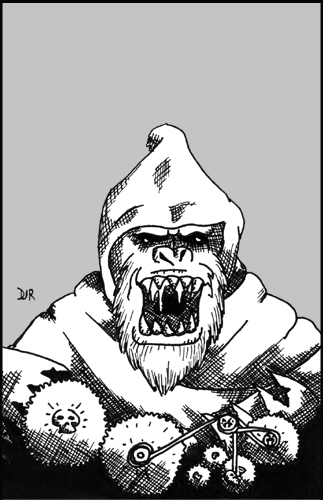 he nationalists are levelled by grey lotus powder.
he nationalists are levelled by grey lotus powder.
Just as his master had taught him, Thak drags away the bodies to conceal his crime. Knowing they will have few opportunities, Conan, Nabonidus and Murilo sprint into the room before the ape returns. The trio may have avoided the deadly trap, but escape from the killer ape is another matter entirely. In order to finally vanquish their tormentor Murilo acts as a decoy while Conan waits in ambush. Barbarian and beast meet in a contest of unbridled primal fury, with Thak ultimately succumbing to the repeated blows of Conan’s poniard.
However, there is one final play to be made. Nabonidus seizes the opportunity to do away with his enemies by grabbing the pull cord for one of his unsprung traps. Conan and Murilo completely in his power, the Red Priest gloats over his victims. But his triumphal celebration is premature. Moving like a panther, Conan grabs a nearby stool and hurls it at Nabonidus’ head with such force that it snaps the man’s neck.
The pair finally leaves the accursed house of the Red Priest – Murilo to his political ambition, and Conan to the unencumbered adventure of the highway.
Thak
“The body was thick, broad and stooped. The unnaturally wide shoulders had burst the scarlet gown… The face peering from the scarlet hood was utterly bestial, and yet Murilo realized that Nabonidus had spoken the truth when he said that Thak was not wholly a beast.” – Robert E. Howard, Rogues in the House.
Nature DC 15: Grey apes are a brutal and savage species of carnivorous primate that dwell in lonely mountains and hills. Their minds are more developed than true apes, and they often employ crude tools and weapons, though they are no less capable of ripping an enemy apart with their bare hands. It is prophesized that grey apes will one day evolve into a species that will challenge humanity for dominance.
Nature DC 20: Unscrupulous criminals often take advantage of the grey ape’s near human intellect by training them as terrifying and savage guards. Some specimens have even learned the art of trap-making. Such creatures are dangerous to own, as they resent captivity and often use their skills against the masters who taught them.
Thak in Combat
Thak’s intelligence allows him to employ strategies in combat few would expect from a bestial ape. Using techniques mimicked from his human master, Thak attacks from ambush, activating traps and hurling enemies into pitfalls and other hazards. Once wounded though, Thak’s animalistic nature takes control, and the ape becomes consumed with a rage that only tearing into his enemies bare handed can sate.
Encounters
Thak is equally at home in a pack of his brethren surrounded by crude jungle-forged snares as he is guarding a sophisticated thieves’ den with intricate magical and mechanical traps.
Notes
The first of many apes! Seriously, Robert E. Howard really liked Conan to face off against primates, and the stories are filled with them. So much so, that when I first told one of my friends about the Monsters of the Hyborian Age project he figured it would just be a compendium of apes. I guess the whole ‘missing link’ thing fit well with weird fantasy and made them more frightening than regular humans or animals (in an uncanny valley way).
Mechanically, I figured that since traps in 4e work essentially like monsters, than the best bet would be to make Thak a Leader and have his ally enhancing abilities work for traps instead of creatures. Since remotely activating a trap essentially gives him another attack, I made him an elite.
I will try my hardest to make the various simian creatures of Howard’s stories different enough to warrant a separate stat-block and prevent this series from turning into ‘candy apple island’. Just a warning though – the next story also features one of the infamous grey apes, but it looks like Shadows in the Moonlight is going to generate a two-parter, so at least it won’t be all ape.
The Pool of the Black One – Part Two
May 5, 2011 This is the second creature from Robert E. Howard’s The Pool of the Black One (well, sort of a creature). For the summary of the story as well as the black one thug and the voice of silence, click here.
This is the second creature from Robert E. Howard’s The Pool of the Black One (well, sort of a creature). For the summary of the story as well as the black one thug and the voice of silence, click here.
Spoiler Alert! All of these Hyborian age posts are going to be filled with spoilers. From the summary, to the monster stats they are going to ruin any surprises as to what the monster is, when they pop up in the story and how and why they are killed. You’ve been warned.
Emerald Pool of Sacrifice
The emerald pool of sacrifice plays an important role in the vile society of the black ones, both as a focal point for their infernal religion and as a torture device for their depraved amusement. The opaque, green fluid that fills the pool is suffused with anti-life. It strips away the life essence of those immersed in the water so violently that it leaves the body of the victim a small, compressed statuette with the consistency of petrified bone.
In their weird cities of green glass, the black ones spend generations collecting these grisly trophies. It is unknown what role they play in the creatures’ religion, but the black ones guard the remains of their victims with zeal.
Notes
There is a moment of horror in the story, when Conan realizes that the rows of statuettes were once people, which I thought would work perfectly for a D&D encounter. Petrification is a staple of the game, but it’s hard to get that feeling of dawning dread anymore – the medusa’s garden filled with statuary is cool, but a cliché that players have come to expect. Despite the story being as old as it is, I thought its titular pool could add an interesting twist to petrification.
I made the pool peter out as it ran out of targets, which is counter to the story, but I wanted it to be useful for the widest variety of encounters. Alternatively, you could have the pool trigger a skill challenge after 10 rounds, simulating the PCs flight from the city of the black ones (the whole ‘running from the wave of lava’ thing). Of course, if you wanted this to be a plot point, you’d have to make sure that a creature sacrificed itself during combat, which, depending on how it was handled could seem overly heavy handed by some players.
The Pool of the Black One – Part One
March 19, 2011The Pool of the Black One is Howard’s first pirate themed Conan yarn (although Conan’s past as a pirate was hinted at in The Scarlet Citadel) and establishes the rivalry between the Zingaran freebooters and the Barachan pirates. It’s also a fun blending of weird fantasy and grimy, pirate adventure – an indispensable read for anyone who’s a fan of Green Ronin’s Freeport series of adventures.
Once again though, the female character is problematic and I think I’ve finally put my finger on what bothers me about Sancha (and Natala for that matter). It’s not the ownership of women (Howard uses slavery as one of his criticisms of ‘civilization’), or that every women jumps into Conan’s bed by the end (which intimates that the only currency women have is their bodies – but this is a well established pulp adventure trope that’s continued into the action movies of today so I can hardly single Howard out for that). What bothers me is when Howard’s female characters lack any agency, any way of impacting events in the world for themselves without attaching themselves to another character. Not all his female protagonists are like that, I guess with the last two stories in a row it was just getting to me a little.
Spoiler Alert! All of these Hyborian age posts are going to be filled with spoilers. From the summary, to the monster stats they are going to ruin any surprises as to what the monster is, when they pop up in the story and how and why they are killed. You’ve been warned.
Summary
The story begins with Conan fleeing the Barachan Isles on a leaking rowboat, and then making a swim for the first ship he sees – the Wastrel, captained by the freebooter Zaporavo. There is a tense moment between the men while the captain decides what to do with the Cimmerian. Ultimately, he chooses to let Conan join the crew instead of ordering his men to cut him down. This sets into motion a series of events that will see Zaporavo lose “his ship, his command, his girl, and his life.”
After a failed hazing from the rest of the crew that leaves the offender with a snapped neck, Conan soon earns their respect with his skill as a sailor and his prodigious strength. He also attracts the eye of Zaporavo’s concubine, Sancha.
Following clues left in the legendary scrolls of Skelos, Zaporavo heads into the uncharted west, in search of a forgotten civilization and its ancient treasures. Eventually the Wastrel reaches the forgotten island and Zaporavo orders his crew to stay near the shore and gather supplies while he searches the interior alone. Conan slips into the trees after the captain, bloody business on his mind, while the rest of the crew gorges on strange, golden fruit.
Conan soon reaches his quarry, and away from the prying eyes of the crew, duels Zaporavo for the Wastrel. After slaying the Zingaran, Conan continues inland, his curiosity piqued at his former captain’s quest for treasure. There he finds a strange city peopled by tall, mute, dark skinned creatures with diabolical features. From his hiding place he sees the creatures torture the Wastrel’s cabin boy and use a magical green pool to transmute him into a tiny, petrified statue.
While Conan weighs his options, he sees that the creatures have captured Sancha, as well as the rest of the crew, who are in a drugged stupor from eating the island’s fruit. The Cimmerian draws his blade and dives into combat, buying the rest of the freebooters enough time to get to their feet and for Sancha to get them their weap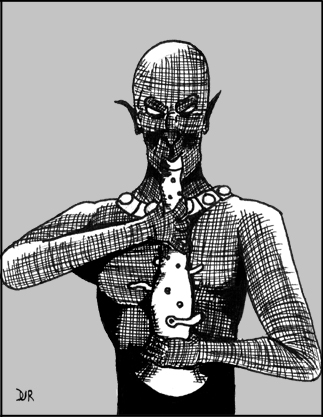 ons (I guess she isn’t completely helpless). A viscous melee follows, with losses on both sides, but the invaders have the advantage of numbers, and the dark skinned giants rout.
ons (I guess she isn’t completely helpless). A viscous melee follows, with losses on both sides, but the invaders have the advantage of numbers, and the dark skinned giants rout.
Cornered in front of the pool, the leader of the creatures breaks his silence in a howl of pure hatred and sacrifices himself into the mystic green waters. The pool erupts in a volcanic geyser, unleashing a sentient wave of death in the freebooters’ direction. Grabbing Sancha, Conan and the rest of the crew make a run for the shore, barely escaping the eerie green river chasing them.
Though ragged and bereft of any bounty, Conan has won the affections of Sancha, the Wastrel and a crew eager for the plunder of more populated waters.
Black Ones
“These creatures were black and naked, made like men, but the least of them, standing upright, would have towered head and shoulders above the tall pirate. They were rangy rather than massive, but were finely formed, with no suggestion of deformity or abnormality, save as their great height was abnormal. But even at that distance Conan sensed the basic diabolism of their features.” – Robert E. Howard, The Pool of the Black One.
Nature DC 15: The creatures known as the black ones are the result of a divergent offshoot of evolution, one that branched from humanity in the dim days of prehistory. There is a marked diabolical influence in their features, and it may be that the black ones are the result of infernal tampering, many ages before the creation of the Tiefling bloodline.
The black ones live in open air cities with glass-like walls, where they enact foul rituals and pursue strange pleasures in the name of their perverse religion. It is said these cities hold ancient knowledge and treasure for those brave enough to risk the black ones’ wrath.
Nature DC 20: The black ones have no spoken language and communicate with one another telepathically. Although it is possible for them to speak with other creatures in this manner, their disdain for all other intelligent life makes the idea repulsive to them. Legend holds that the leaders of the black ones are capable of vocalizing their hatred in an obscene howl that can blast their enemies.
Encounters
It is extremely rare to find the black ones cooperating with other intelligent races. They are xenophobic, whose only contact with other humanoids is to capture victims to sacrifice in infernal rituals. However, these rituals often bind assassin imps, spined devils, and pain devils into service. Though the concept of a pet is alien to them, the black ones have been known to use behemoths as living weapons when the need arises.
Black ones guard their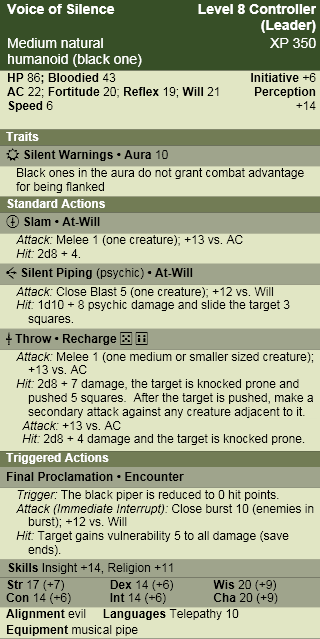 cities with magical traps and hazards, which often feature prominently in their religious practices and blasphemous entertainment.
cities with magical traps and hazards, which often feature prominently in their religious practices and blasphemous entertainment.
Black One Thug
“Conan knew that if he fell foul of that mass of taloned muscle and bone, there could be but one culmination. Once let them drag him down among them where they could reach him with their talons and use their greater body-weight to advantage, even his primitive ferocity would not prevail.” – Robert E. Howard, The Pool of the Black One.
Black One Thugs in Combat
Though they may appear as naked savages to the civilized eye, black one thugs are calm and collected in combat. They have no need for armor or weapons, their own bodies being sufficient to deal with the threats of their environment. When attacking, thugs select the most dangerous adversary in a group, surround, drag them to the ground, and mercilessly stomp the life out of them. Weaker foes are left alive to be captured for sacrifice and loathsome amusements.
Voice of Silence
“One, squatting on his haunches before the cringing boy, held a pipe-like thing in his hand. This he set to his lips, and apparently blew, though Conan heard no sound. But the Zingaran youth heard or felt, and cringed. He quivered and writhed in agony; a regularity became evident in the twitching of his limbs, which quickly became rhythmic.” – Robert E. Howard, The Pool of the Black One.
Voice of Silence in Combat
The voice of silence is the spiritual leader of a community of black ones, presiding over the diabolic rituals around which their strange cities are organized. They focus their mental powers through their pipes, which transmit thought waves instead of sound, and can force the weak willed to dance and jig like a puppet on a string. The voice of silence uses this power in combat to force foes into dangerous hazards and isolate powerful individuals for gangs of black one thugs to overpower.
Notes:
Combined with a hazard or trap (coming soon in part 2) I think that the voice of silence and a group of black one thugs would make a good encounter. Theoretically all sorts of black ones could be created for an extended adventure into one of their cities – a fast skirmisher that can drag off captives (as happened to Sancha), or even an artillery that hurls chunks of broken glass that shatter on impact (that’s not in the story, but I think it fits and it sounds cool).
When I started this project I had intended to use the chronology of the stories as a guide to assigning levels to these creatures (and I’ll still keep that in mind), but that doesn’t always translate well into the game. Most accounts put The Pool of the Black One fairly late in Conan’s career, but the piratical adventure just didn’t seem like paragon tier material to me, so I kept it to the high heroic level. For a paragon version of these creatures I would probably (in addition to upping the damage and attack bonus) add slow (save ends) to the silent piping, daze (for 1 round) to the throw, and a bonus to damage for the thugs if more than two of them are adjacent to a character (like gnolls).
